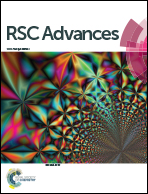Bis(2-(benzo[d]thiazol-2-yl)-5-fluorophenolate)beryllium: a high-performance electron transport material for phosphorescent organic light-emitting devices†
Abstract
A beryllium complex, Be(FBTZ)2 (HFBTZ: 2-(benzo[d]thiazol-2-yl)-5-fluorophenol), has been synthesized with the aim of developing electron transport materials (ETMs) for phosphorescent organic light-emitting diodes (PhOLEDs). The complex exhibits a high triplet energy of 2.62 eV which is able to confine triplet excitons of green or lower-energy emissive phosphorescent emitters within the emitting layer. Moreover, it possesses a low-lying LUMO energy level (−3.14 eV) allowing efficient electron injection and a high election mobility of 1.8–1.1 × 10−4 cm2 V−1 s−1 for efficient electron transport. These characters enable Be(FBTZ)2 to act as an excellent ETM in PhOLEDs. By using the complex as an electron transport layer (ETL), structurally simple green, yellow and red PhOLEDs exhibiting extremely low turn-on voltages (Von) of 2.3, 2.1 and 2.2 V and high power efficiencies (PE) up to 65.0, 84.9 and 23.1 lm W−1, respectively, have been successfully fabricated. Be(FBTZ)2 can also work as a host material for PhOLEDs as demonstrated by a green device with a maximum PE of 42.8 lm W−1 and a Von value of 2.3 V.
![Graphical abstract: Bis(2-(benzo[d]thiazol-2-yl)-5-fluorophenolate)beryllium: a high-performance electron transport material for phosphorescent organic light-emitting devices](/en/Image/Get?imageInfo.ImageType=GA&imageInfo.ImageIdentifier.ManuscriptID=C5RA24244D&imageInfo.ImageIdentifier.Year=2016)

 Please wait while we load your content...
Please wait while we load your content...